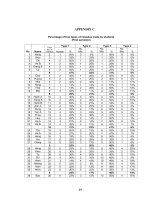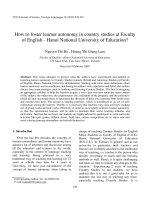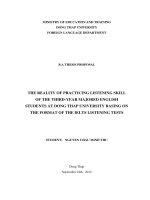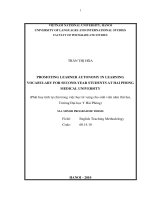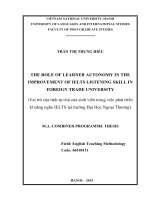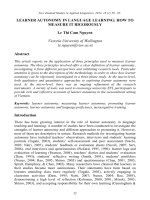THE ROLE OF LEARNER AUTONOMY IN THE IMPROVEMENT OF IELTS LISTENING SKILL IN FOREIGN TRADE UNIVERSITY
Bạn đang xem bản rút gọn của tài liệu. Xem và tải ngay bản đầy đủ của tài liệu tại đây (883.12 KB, 106 trang )
VIETNAM NATIONAL UNIVERSITY, HANOI
UNIVERSITY OF LANGUAGES AND INTERNATIONAL STUDIES
FACULTY OF POST-GRADUATE STUDIES
TRẦN THỊ TRUNG HIẾU
THE ROLE OF LEARNER AUTONOMY IN THE
IMPROVEMENT OF IELTS LISTENING SKILL IN
FOREIGN TRADE UNIVERSITY
(Vai trò của tính tự chủ của sinh viên trong việc phát triển
kĩ năng nghe IELTS tại trường Đại Học Ngoại Thương)
M.A. COMBINED PROGRAMME THESIS
Field: English Teaching Methodology
Code: 60140111
HANOI – 2015
VIETNAM NATIONAL UNIVERSITY, HANOI
UNIVERSITY OF LANGUAGES AND INTERNATIONAL STUDIES
FACULTY OF POST-GRADUATE STUDIES
TRẦN THỊ TRUNG HIẾU
THE ROLE OF LEARNER AUTONOMY IN THE
IMPROVEMENT OF IELTS LISTENING SKILL IN
FOREIGN TRADE UNIVERSITY
(Vai trò của tính tự chủ của sinh viên trong việc phát triển
kĩ năng nghe IELTS tại trường Đại Học Ngoại Thương)
M.A. COMBINED PROGRAMME THESIS
Field: English Teaching Methodology
Code: 60140111
Supervisor: Dr. Duong Thi Nu
HANOI – 2015
DECLARATION
I hereby certify my authority of the research submitted entitled “The role of
learner autonomy in the improvement of IELTS listening skill in Foreign Trade
University” in partial fulfillment of the requirements for the degree of Master of
Arts.
Hanoi 2015
Tran Thi Trung Hieu
i
ACKNOWLEDGEMENTS
I would like to express my deep gratitude to Dr Duong Thi Nu - my research
supervisor, for her patient guidance, enthusiastic encouragement and useful
critiques of this research work. I would like to thank my classmates Ms Trang and
Ms Hanh, for their advice and assistance in keeping my progress on schedule.
I would also like to extend my thanks to my academic staff from my Faculty of
English for Specific Purposes in Foreign Trade University for their help in offering
me the resources to enrich my research. My grateful thanks are also extended to my
dear students for their helpful enthusiasm and sincere sharing during my procedures
of data collection.
Finally, I wish to thank my dear family, my beloved husband and my sincere
friends for their support and encouragement throughout my study.
ii
ABSTRACT
The effects of learner autonomy have been shown to play an important role in
language education. However, we have not really progressed in autonomous
learning application. There has been little research on the role of learner autonomy
in the improvement of listening skill in universities. This study was designed
investigate the relationship between learner autonomy and IELTS listening score in
Foreign Trade University (FTU). A survey research was adopted in this study and a
design of questionnaires and interviews was employed as the main instruments of
the study. The population included all first -year students from 7 CLC classes in the
different departments in Foreign Trade University; about 175 students. The 36
students enrolling CLC program from Business Management Department are the
sample chosen for this study. A convenient sampling design was used in this study.
Data were collected through two phases of the study, utilizing both quantitative
method (survey questionnaires) and qualitative method (semi-structured individual
interviews). Results reveal that IELTS listening autonomous learning enables
students to perform significantly better.
iii
TABLE OF CONTENTS
Tran Thi Trung Hieu i
ACKNOWLEDGEMENTS ii
PART A: INTRODUCTION 1
2.Aims and Objectives of the study 4
7.Design of the Study 6
PART B: DEVELOPMENT 7
CHAPTER 1: LITERATURE REVIEW 7
1.4. IELTS &Banks of Official IELTS 15
1.5. Listening 16
CHAPTER 2: METHODOLOGY 25
2.1. The context of the study 26
2.3. Research design 33
3.1. Results 43
3.1.1. Questionnaire results 43
3.1.2. Interview results 52
3.2. Findings 58
CHAPTER 4: DISCUSSIONS AND RECOMMENDATIONS 61
4.1. Contribution of the study to existing literature 62
4.2. Recommendations 64
PART C: CONCLUSION 66
1. Summary of results and findings 66
2. Limitations 67
3. Suggestions for further research 68
iv
LIST OF FIGURES
Figure 1: Attitudes and abilities to self-regulate their learning of category 1
Figure 2: Attitudes and abilities to self-regulate their learning of category 2
Figure 3: Attitudes and abilities to self-regulate their learning of category 3
Figure 4: Comparison among 3 categories in terms of their agreement
Figure 5: Comparison among 3 categories in terms of their “no idea”
Figure 6: Comparison among 3 categories in terms of their disagreement
v
LIST OF TABLES
Table 1: Description of Autonomy
Table 2: Converting IELTS mark for first-year CLC students
Table 3: Background information about the subjects of the study
Table 4: The results of the final test of 3 categories
Table 5: The results of entry test and final test of the whole class
vi
LIST OF ABBREVIATIONS
CLC: Chất Lượng Cao
FTU: Foreign Trade University
IELTS: International English Language Testing System
L2: Second Language
ESP: English for Specific Purposes
TESOL: Teaching English to Students of Other Languages
MOET: Ministry of Education and Training
vii
PART A: INTRODUCTION
1. Rationale of the study
Learner autonomy in language learning has attracted a large number of
researchers all over the world with a great deal of the research originating in Europe
(see Holec, 1981; Little, 1991; Dam, 1995). It has been further studied and
promoted by Asian researchers in countries such as Hong Kong (Benson, 2001;
Littlewood, 2007) and Japan (Aoki & Smith, 1999; Aoki, 2001). The research on
learner autonomy recognizes the benefits and the possibility of fostering learner
autonomy in language education (Benson, 2007). In 1980, Holec mentioned the
main purpose of language teaching as “to help the learner acquire the linguistic
communicative abilities he has defined for himself” (Finch, 2001: 7). When we
consider this purpose of teaching language, it may be obvious that an autonomy is a
necessity in the learning process which can be handled by the learners not by the
teachers. It will be more effective and long lasting if the role of teachers in the
learning process is limited to show students how to acquire the knowledge in a
suitable way as the motto of strategic learning “life long lasting”.
Traditionally, language curriculum has aimed to teach knowledge and skills,
and has neglected to teach learners the way to learn. Mostly the main elements of
learning will be the teacher and then the learners. The teaching method that the
“teacher does to their learners” (Little, 1993, p.3) has been widely applied. The
teachers were and are always be the only people who take charge of all the
knowledge which is necessary for the learners on the assumed items. The increase
in learning demands with the change of technology, social values, and standard life
brings about the change of role of teachers. A new term-“self-directed learning”- or
–“autonomy”- has emerged nearly at the end of 1970’s. Learner training in second
or foreign language teaching is a new way of teaching learners explicitly the
techniques of learning, and an awareness of how and when to use strategies to
enable them to become self-directed (Williams and Burden 1997). Today, therefore,
1
there is a growing trend to explore learner autonomy in foreign language contexts
(Benson, 2013). The trend, however, has been to research the application of learner
autonomy in particular educational contexts such as in mainstream language
education environments (Benson, 2007). This research recognizes the global trend
of an increasing approach to learner-centered education in the context of Vietnam as
the result of current needs:
- Needs from students: Littlewood’s (2000) study show that learners are not
that passive and they now do not wish to be merely “obedient listeners”
(p.33) but “they would like to be active and independent” (Littlewood, 2000,
p. 34). This is clearly a new direction of investigating how students learn and
want to learn in Vietnam. In another study with 300 Vietnamese learners of
English, Tomlinson and Dat (2004) reported that learners would be eager for
changes to the culture of their classrooms. However, most teachers in the
study were unaware of what their students felt and thought about the
methodology of their courses (Tomlinson & Dat, 2004)
- Needs from teachers: Dang (2010) mentioned that “being strongly
considered part of the Eastern culture, teaching and learning in Vietnam is
more teacher-centered” (p. 5). Nonetheless, “teachers of English in Vietnam
seem to have accepted that the grammar-translation method is not effective
in English language teaching and learning” and that “they have begun to
realize that communicative teaching method and student-centered approaches
are what they need to implement in their teaching” (Brogan & Nguyen, 1999,
p. 3) to improve students’ learning.
- Needs from the government: Nowadays, it is necessary that education and
training must not only be able to equip students with new scientific and
cultural knowledge but also develop their reasoning, creative abilities and
team work skills (Moet, 2005). As a result, perceptions about teaching and
learning philosophies should be changed by Vietnamese educational
authorities (Pham, 2008). They have put into consideration that the
traditional teaching and learning approach, with its emphasis on individual
2
achievement and transmission of information has become inadequate in
developing students’ thinking and learning skills in current global society
(Dang, 2010). Therefore, the importance of learner autonomy has been
acknowledged in a new educational policy number: 43/2007/QD-BGDDT
(Moet, 2007, p.3) issued by the Vietnamese government. In this policy,
managing and teaching by credit system is strongly emphasized “One credit
point is equivalent to 15 class hours. In order to learn well, students must
spend at least 30 hours of preparation for an equivalent credit point”. This
policy aims to develop more autonomous learning with more active and
responsible students, then to develop lifelong and autonomous learners.
According to this new policy, all universities and institutions have to adapt
their syllabus and teaching and learning processes to a central accreditation-
based system, which includes the development of learner autonomy. It is
suggested that teaching strategies should be changed to meet the expectations
of the new requirements. Students’ roles are to become more active and
responsible for their studies because they have now got the chance to choose
their own courses and teachers and so they themselves must learn how to
manage their time and learning process.
To date, there have been few studies that focuses on the role of learner
autonomy in listening skills in general and in IELTS listening skills in particular. In
fact, teaching IELTS is a combination of English language training and IELTS
examination requirements and procedures in order that when students take this
exam, they are better able to produce their best results. There is no magic remedy
for getting a high band in the exam. Students themselves will be guaranteed to have
a good knowledge of English and to be more active and responsible for their studies
in order to achieve a band score which will make them eligible to follow CLC
curriculum in Foreign Trade University (FTU). In other words, autonomous
learning in IELTS listening skills has been strongly encouraged with the support
from the teacher. As a starting point, the current research argues that in order to
understand how learner autonomy can be effectively applied in FTU, its role in the
3
improvement of IELTS listening skills is necessary to be investigated in generally
Vietnamese educational context and particularly Foreign Trade University.
2. Aims and Objectives of the study
The main aim of this study was to investigate the role of learner autonomy in
the improvement of IELTS listening, especially to identify the role of students’
attitudes and their abilities to self-regulate their learning in the improvement of
IELTS listening skill in Foreign Trade University. Personally, it is challenging
when taking charge of first-year CLC students. Such CLC ones are assigned to
achieve an essential band score of IELTS to meet the linguistic demands of Foreign
Trade University. That effectively counts only if there exists enthusiastic lecturer
involvement and excellent student performance, especially students’ autonomous
learning. As a matter of fact, the students are not well-aware of autonomy.
Therefore, I would like to conduct a survey research so that the goal is achieved.
To be more specific, the primary objectives were set as shown below:
- To investigate the students’ attitudes and abilities to self-regulate their
learning towards IELTS listening skills at Foreign Trade University (FTU)
- To identify the effects of autonomous learning in IELTS class at FTU on the
improvement of first-year CLC students’ IELTS listening band score.
3. Research questions
To achieve the aims and objectives, the following research questions were
formulated and needed to be answered satisfactorily:
(1) What are the students’ attitudes towards autonomous learning for IELTS
listening?
(2) How do students’ attitudes towards autonomous learning affect their IELTS
listening tests?
4. Methodology
To find the answers to research questions, a survey research was adopted in
this study, a design of questionnaires and interviews was employed as the main
4
instruments of the study. The population included all first -year students in 7 CLC
classes in the different departments of Business Management, Banking and Finance
and International Economics; about 175 students. The 36 students enrolling CLC
program from Business Management Department are the sample chosen for this
study. A convenient sampling design was used in this study. Moreover, tests were
used as the additional instrument to see the students’ improvement and support
main instruments to find the answers to research questions.
5. Scope of the study
The study will not discuss the effectiveness of learner autonomy in learning
all skills of official IELTS tests, but focus on listening skill only. This is also a
situational study in the learning and teaching IELTS setting of Foreign Trade
University with the population of 175 students. 36 CLC students in the researcher’s
own classroom will be the sample and respondents to the questionnaire, in-depth
individual interviews of the method themselves. Since this study is carried out to
figure out learner autonomy in learning IELTS listening of CLC students in FTU,
the results of the questionnaire will give the researcher supplementary support for
the conclusion drawings. Thus, the findings of this paper may not be necessarily
generalized to students at other universities.
6. Significance of the study
The research on the role of autonomy plays a significant part, especially
meaningful to pupils that have just graduated from high schools and entered new
university environment with new teaching methods. If students still keep applying
traditional teacher-centered learning method at universities, they will be overloaded
with wide knowledge that teachers cannot transmit in limited time. If their learning
methods have not been gradually changed, especially to specialized IELTS practice,
it turns out difficult to get high band scores. Moreover, a variety of IELTS materials
confuses students; then, they get difficulty making good selections of sources
relevant to their language competence and CLC requirements. Time arranged for
each lesson has just been enough for lecturers to introduce sources for students to
get know well and guide them some necessary tips based on listening techniques to
5
practice at class. Their autonomous performance involves students’ attitudes and
abilities to control their own learning, their own learning strategies and self-search
for further practice and Cambridge IELTS Tests, Online Banks of Official IELTS,
and so on… are some of suggestions. That is a good opportunity for students to
come into contact with real tests, self-evaluate their strengths and weaknesses in
IELTS study, and consider whether their practice materials currently suit their
ability and meet first-year linguistic demands.
7. Design of the Study
The study is divided into three parts, which are presented as follows:
Part A (Introduction) provides an overview of the study, containing the rationale of
the study, aims and objectives, research questions, research methodology, scope,
significance and the design of the study. Part B (Development) consists of 4
chapters. Chapter 1 presents literature review relevant to the study. This chapter
provides the background knowledge of learner autonomy, learner autonomy in
language learning, the importance of learner autonomy, IELTS test, general
listening and IELTS listening. This part also illustrates some related research
(literature review) conducted by other researchers as well as their gaps in the field
which inspire the writer to conduct the study. Chapter two describes the
methodology underlying the research, which presents the context of the study, the
rationale for using survey research, the details about the participants and all
instruments employed by the researcher as well as procedures to collect data.
Chapter three presents the process of data analysis. Chapter four is devoted to a
detailed description of the significant findings from data collection, and discussions
after analyzing gathered data from described instruments. Part C (Conclusion)
presents the conclusion which focus on the findings and summary of the main
points of the study. This chapter also points out several limitations of the research as
well as some implications which presents some further recommendations for the
effective application of learner autonomy in IELTS CLC class as well as
suggestions for further study.
6
PART B: DEVELOPMENT
CHAPTER 1: LITERATURE REVIEW
This Chapter reviews the relevant literature to the study and explanation of
some key terms in the study. This chapter begins with the definition of learner
autonomy, learner autonomy in language learning and its importance, some
information about IELTS test, listening skill in general and IELTS listening skill in
particular and some related research-literature review of learner autonomy.
1. Theoretical background
1.1. Definitions of Learner Autonomy
The term “autonomy” which is derived originally from the fields of politics
and moral philosophy, is a slippery term because it is widely confused with self-
instruction and independent learning. It is also a multifaceted concept whose
meaning has been discussed from many perspectives by theoreticians (Benson 2001,
2007). The below table representing the definitions of autonomy made by different
thinkers is adopted from Finch (2001: Appendix 1-2)
Table 1: Description of Autonomy
Name Definition
1 Holec (1981) The ability to take charge of one’s own learning… This
ability is not inborn but must be acquired either by
“natural” means or (as most often happens) by formal
learning, in a systematic, deliberate way.
2 Young (1986) Authoring one’s own world without being subject to
the will of others
3 Dickinson
1. (1987)
Complete responsibility for one’s learning, carried out
without the involvement of a teacher or pedagogic
materials.
7
2. (1992) An attitude towards learning in which the learner is
prepared to take, or does take, responsibility for his
own learning.
4 Boud (1988) Students take some significant responsibility for their
own learning over and above responding to instruction.
5 Hunt, Gow and
Barnes (1989)
Decision-making process involved in identifying
problems and making relevant decisions for their
solution through access to sufficient sources of
information.
6 Little, D.
1.(1989)
2.( 1991)
The goal of all developmental learning and, is,
moreover, fundamental to its processes. Acceptance of
responsibility for one’s own learning.
A capacity for detachment, critical reflection, decision
making and independent action.
7 Allwright
(1990)
A constantly changing but at any time optimal state of
equilibrium between maximal self-development and
human interdependence.
8 Wenden, A. (1991) In effect, successful or expert or intelligent learners
have learned how to learn. They have acquired the
learning strategies, the knowledge about learning, and
the attitudes to enable them to use these skills and
knowledge confidently, flexibly, appropriately and
independently of a teacher. Therefore they are
autonomous.
9 Kant (1991) Foundation of human dignity
10 Legutke and Thomas
(1991) and
Littlewood (1996).
An ability that has to be acquired (learning how to
learn) and is separate from the learning that may take
place when autonomy has been acquired.
11 Benson, P.
1.(1996)
The concept of autonomy is indeed beginning to enter
the mainstream of language learning methodology.
8
2. (1996) Autonomization is necessarily a transformation of the
learner as a social individual… autonomy not only
transforms individuals, it also transforms the social
situations and structures in which they are participants
12 Cotteral, S. (2000) Autonomy is an incontrovertible goal for learners
everywhere, since it is obvious that no students,
anywhere, will have their teachers to accompany them
throughout life.
13 Fenner, A. (2000) An attitude or even a philosophy than a methodology
14 Shrader, S.R. (2003) Self-directed learning or a shift of responsibility for
learning from teacher to student.
From these definitions, it is clear that researchers try to explain autonomy in
five main categories: 1. an inborn capacity which is supposed by institutional
education; 2. a set of skills which can be learned and applied in self-directed
learning; 3. situations in which learners study entirely on their own; 4. the emphasis
of learners’ responsibility for their own learning; 5. the right of learners to
determine the direction of their own learning. (Benson and Voller, 1997:1)
While the first time when the term ‘learner autonomy’ was used in second
language education is not known, it first appeared officially in the Council of
Europe Modern Languages Project in 1979 by Holec. This resulted in the
publication of Holec’s 1981 seminal report (Holec, 1981), in which he defined
learner autonomy as “the ability to take charge of one’s own learning” (p. 3).
Benson (2007a: 22) remarks that ‘Holec’s (1981) definition of learner autonomy has
proved remarkably robust’ and Little (2007: 15) has recently described it as a
‘foundational definition’.
Following this, learner autonomy with various other definitions have been
considered. For instance, Wenden (1999) recognized the importance of
metacognitive awareness when she claimed that true learner autonomy mentioned
how students reflect on their learning and how they are able to realize when they
have effective learning opportunities. In another example, Littlewood (1996) took
9
the notion of autonomy as “learners’ ability and willingness to make choices
independently” (p. 427). He argued that “this capacity depends on two main
components: ability and willingness” (p. 428). These two abilities are
interdependent and are divided into subcomponents of knowledge about the
alternative choices and skills available for carrying out appropriate choices.
Willingness depends on the motivation and confidence a person has in order to take
responsibility for necessary choices. In order to become autonomous successfully, a
person needs to have the four subcomponents of knowledge, skills, motivation, and
confidence. Littlewood also suggested that these components be focused in the
development of learner autonomy.
In short, definitions of learner autonomy have been varied (Littlewood
(1999: 71)). However, the basis of autonomy has always been the ability to take
responsibility for (or take control/charge of) one’s own learning (Cotterall ((1995:
195); Dickinson (1995: 165); Little (1999); Littlewood (1999: 71); Benson (2006:
21); Little (2007: 14)). This definition of learner autonomy is also used for the
current research: Autonomy refers to abilities and attitudes (or whatever we think
the “a capacity to control your own learning”). The point is, then, that “learning by
yourself is not the same thing as having the capacity to learn by yourself. Also,
autonomous learners may be better than others at learning by themselves, but they
do not necessarily have to learn by themselves”. (Nguyen (2014:16))
1.2. Learner autonomy in language learning
In fact, in the traditional education setting, the main and most important
element is the teacher, then the learners. The teachers are responsible for all of the
learners and their learning process. They were and are always be the only people to
decide necessary information for the learners from delivering, explaining,
motivating, setting standards for this piece of knowledge to assessing them. For
more details, they have to supply the knowledge, transmit the knowledge, set the
standards of the knowledge or learning and also motivate the learners to absorb the
knowledge and finally assess the improvement of the learners meanwhile assess
themselves as the information provider at the end of each semester. In terms of
10
responsibilities of the learners, it is clear that their main role is to achieve the
standards set by the teachers at the beginning of each semester. To reach this goal,
they may absorb the information, display understanding and skill, apply the theory
into practice. Obviously, the traditional education system has put a great pressure on
the shoulders of the teachers.
Also in Vietnam, traditionally, teaching and learning English is limited to
giving students lessons and far from teaching them how to learn; that is, the main
task of the teacher is to transmit the knowledge to his/her students (Trinh, 2005)
rather than encouraging students to become autonomous in their learning. Kramsch
and Sullivan (1996) studied that teachers are traditionally considered as masters of
knowledge in the classroom. Researchers (Mumphreys & Wyatt, 2014; Nguyen,
Toulouw & Pilot, 2006) indicated that Vietnamese learners have been influenced by
the Confucian perspective in that there are “traditional beliefs of relational hierarchy
in classrooms, where the roles of teachers and learners are rooted deeply in people’s
thinking” (Ho & Crookall, 1995, p. 237). Students are in these classes not aware of
construct the information that they receive from the teachers. They tend to be
dependent and believe that all the knowledge from teachers seem to be all right. In
the classroom, the students are passive and not directly confront teachers. This
would be disrespectful and cause the teacher to lose face. As a consequence, schools
are formed in a structure where the authority is not shared; individuality and
creativity are less encouraged (Harman & Nguyen, 2009). In short, developing
learner autonomy in the traditional system tends to be insupportable during the
learning and teaching process.
The changing world urgently demands for the change in teachers’ roles and
new term-“self-directed learning”- or –“autonomy”- has emerged as a result of that
fact. In language teaching, Holec is one of the thinkers who mostly prefers to use
the word autonomy instead of the other words such as self-directed learning used
for autonomy. In Holec (1980) it is indicated that “adult education becomes an
instrument for arousing an increasing sense of awareness and liberation in man, and
in some cases, an instrument for changing the environment itself”. From the idea of
man ‘product of his society’, one moves to the idea of man ‘producer of his society’
11
(Finch, 2001:2). Related to this movement, a number of learner-centered approaches
took place in 1980’s and in 1990’s which mainly included autonomy as the basis of
their curriculum. These are briefly learner-training (Ellis and Sinclair 1989;
Dickinson 1992), the learner-centered curriculum (Nunan 1988c), learning-strategy
training (Oxford 1990b; Wenden 1991a), the project-based syllabus (Legutke and
Thomas 1991), and learner-based teaching (Campbell & Kryszewska, 1992). All
these approaches are named by many of the researchers as the early work on learner
autonomy which was developed in 1980’s by Strevens, Holec Allwright, Dickinson,
Wenden and Rubin, Little, Devitt and Singleton, etc (Finch, 2001: 2).
Among a number of terms related to ‘self-directed learning’, the most
popular one nowadays is “autonomy”. It has been mostly agreed that autonomy and
autonomous learning are not directly the synonyms of ‘self-directed’, 'self-
instruction', 'self-access', 'self-study', 'self-education', 'out-of-class learning' or
'distance learning'. These terms can be distinguished in various way and basically
describe various degrees of learning by yourself, while autonomy mentions abilities
and attitudes (or whatever we think “a capacity to control your own learning”). As
mentioned before, this means that “learning by yourself is not the same thing as
having the capacity to learn by yourself. Also, autonomous learners may be better
than others at learning by themselves, but they do not necessarily have to learn by
themselves”. (Nguyen (2014:16)). Autonomy has been widely applied in language
teaching with the pedagogical concerns on ‘learner-centered’ aims and methods that
mainly focuses on the independent learner and how they think, learn and behave.
According to Benson and Voller, “Such an approach is often characterized by
tensions between responsibility and freedom from constraint; between the
individual and the social; and between the view of language learning as a means to
an end (autonomy for language learning) and as an end in itself (language learning
for autonomy)” (1997: 5). There was always a duality in the definition of autonomy.
Overall, a strong link has been found between learner autonomy and self-
regulation According to Perry, Nordby, and VandeKamp (2003: 317), the term self-
regulated is used to describe metacognitive, intrinsically motivated, and strategic
learners. Zimmerman (2002: 64) defines self-regulation as “self-generated thoughts,
12
feelings, and behaviors that are oriented to attaining goals”. According to Wenden
(1995:183) “in the cognitive literature on learning and instruction, autonomous
learning is referred to as self-regulation”. The ability to take responsibility for
learning often refers to learners’ ownership of many learning processes
traditionally owned by teachers such as setting goals; choosing learning methods,
materials and tasks; monitoring and evaluating progress (Ho and Crookall (1995:
235); Cotterall (1995: 195); Littlewood (1999: 71); Benson (2006: 21). These
strategies have been used in the literature to describe both autonomous and self-
regulated learners (e.g. Wenden (1995: 235); Lee (1998: 282); Graham, Harris and
Troia (1998). These characteristics of autonomous and self-regulated learners are
also investigated in the framework of the current research.
1.3. The Importance of Autonomous Learning
In recent years, ideas for the promoting autonomy in language education
remain controversial. However, most researchers are trying to change the
perceptions of autonomous learning of teachers and students, indicate the benefits
on individual enhancement in learning process and effective classroom applications
of learner strategies in their studies. They have been interested in finding the ways
to support their learners to be autonomous. In 1985, Wenden claimed that “learner
strategies are the key to learner autonomy, and that one of the most important goals
of language training should be the facilitating of that autonomy” (Brown 1994:
124). Also, Dickinson (1987) provides five main reasons for supporting self-
instruction (Finch, 2001: 5) such as practical reasons, individual differences among
learners, educational aims, motivation, and learning how to learn foreign languages.
Moreover, Cotteral, Benson and Voller, Brooks and Grundy, Little, Kelly and many
other names also advocated for autonomy or namely self-instructed learning and
commonly agreed on the issues that are mentioned below:
1. a resulting increase in enthusiasm for learning (Littelejohn, 1985);
2. taking an active, independent attitude to learning and independently
undertaking a learning task is beneficial to learning; personal involvement in
decision making leads to more effective learning (Dickinson, 1995);
13
3. when the learner sets the agenda, learning is more focused and purposeful,
and thus more effective both immediately and in the longer term (cf. Little
1991; Holec 1981; Dickinson 1987);
4. when responsibility for the learning process lies with the learner, the
barriers to learning and living that are found in traditional teacher-led
educational structures need to arise (Little 1991; Holec 1981; Dickinson
1987);
5. without such barriers, learners should have little difficulty in transferring
their capacity for autonomous behavior to all other areas of their lives, and
this should make them more useful members of society and “more effective
participants in the democratic process.” (Little, 1991);
6. “…much of the significant language learning which individuals, for
variety of reasons, undertake at different stages in their lives, occurs outside
classroom walls unassisted- some would state unencumbered- by a classroom
teacher” (Finch, 2001: 6).
In short, the benefits of developing learner autonomy in language education
can be summarized into three major areas (Little, 1991). Firstly, as the student is
involved in the decision-making process, “learning should be more focused and
purposeful, and thus more effective both immediately and in the longer term”
(Little, 1991, p. 8). Secondly, as it is the “learner’s responsibility for their learning
process, the constraints between learning and living that are often found in
traditional teacher-centered educational structures should be minimized”
(Littlewood, 1997, p.72). Finally, it is believed that when a student is autonomous
for his/her own learning, it is more likely that (s)he will be responsible in other
areas in his/her life, and as consequence, (s)he will be a useful and more effective
member of the society (Little, 1991). In fact, Littlewood (1997), Dam (2008),
Benson (2008) and Hamilton (2013) have shown the advantages of fostering learner
autonomy in language education in their research. The fact results in the trend of
application of learner autonomy in particular educational contexts such as in
14
mainstream language education environments (Benson, 2007). The current research
also follows this trend.
1.4. IELTS &Banks of Official IELTS
The International English Language Testing System (IELTS) is the world’s
most popular high-stakes English language proficiency test for higher education and
global migration, with more than 2 million tests taken in the last year. IELTS
assesses all of four English skills — reading, writing, listening and speaking — and
is designed to reflect real life use of English — at study, at work, and at play. The
IELTS test is developed by some of the world’s leading experts in language
assessment. It has an excellent international reputation, and is accepted by over
8,000 organizations worldwide, including schools, universities, employers, immigration
authorities and professional bodies.
IELTS is the most widely accepted English language test that uses a one-on-
one speaking test to assess English communication skills. This means that
candidates are assessed by having a real-life conversation with a real person. This is
the most effective and natural way of testing English conversation skills. There are
two versions of the test – IELTS Academic or IELTS General Training – depending
on the organization candidates are applying to and their plans for the future. Both
versions of the test are made up of four parts – Listening, Reading, Writing and
Speaking. IELTS results are graded on the unique IELTS 9-band scale.
Banks of Official IELTS
1. Cambridge Test Series 1-9
2. Latest Publishers for IELTS
- A&C Black
- Cambridge University Press
- Educational Software Products
- Express Publishing
- Macmillan
- Marshall Cavendish Education
- OUP
15
- Pearson Education
- Thomson ELT
- Barron's Educational Series, Inc
1.5. Listening
Before 1970s, listening was only considered as a receptive skill (Johnson,
2008,P.299) where “students listened to repeat and develop a better pronunciation”
(Vandergrift 2011) Although the literature based on listening strategy instruction
has not caught enough attention, strategy instruction for listening task has been
increasingly focused by listening experts such as Goh (2000, 2002), Hasan(2000),
Mareschal (2002) and Vandergrift (2003B) in the past decades.
Initially, most of the listening strategy studies have been investigating patterns
and strategies used by successful versus less successful learners. Gradually the line
of research shifted to focus on effective strategies-based and process oriented
approaches to teaching listening skill in order to guide the students “learn to listen”
so that they can better “listen to learn” (Vandergrift, 2004). Therefore, listening
instructors have the responsibility of teaching students to take advantage of
strategies rather than merely providing students with oral passages and testig them
(Mendelsohn, 1995).
Three types of learning strategies have been applied in listening instruction:
cognitive strategies, metacognitive strategies and socioaffective strategies (Chamot,
1993; Oxford et al.1989; Vandergrift, 1997). Cognitive strategies consist of
inferencing, resourcing and note taking which are unconscious interactions with the
material to be learned. Metacognitive strategies refer conscious management and
regulation over learning process namely planning, concerntrating and monitoring.
Socioaffective involve interacting with peers or management of affection to
facilitate learning, such as asking question, collaborating with classmates and
controlling stress (O’Malley et al.,1989; Oxford et al., 1989; Vandergrift, 1997).
1.5.1. General listening
The researcher would like to consider listening from two different
perspectives: Listening as comprehension and listening as acquisition.
Listening as comprehension
16

